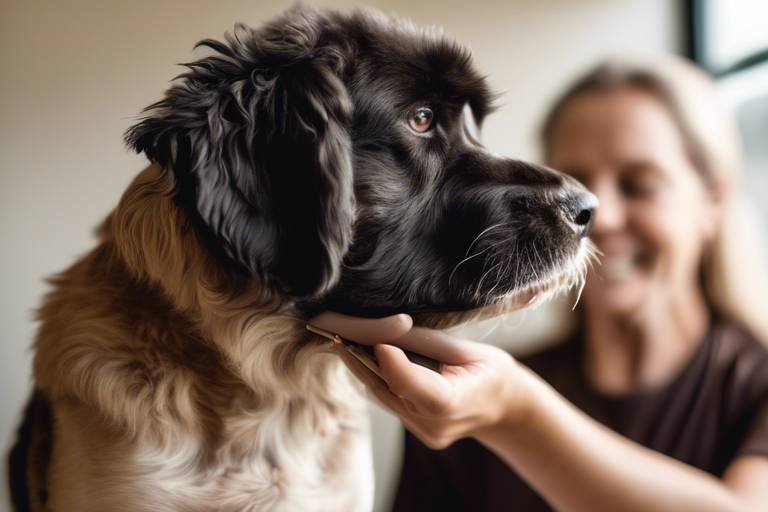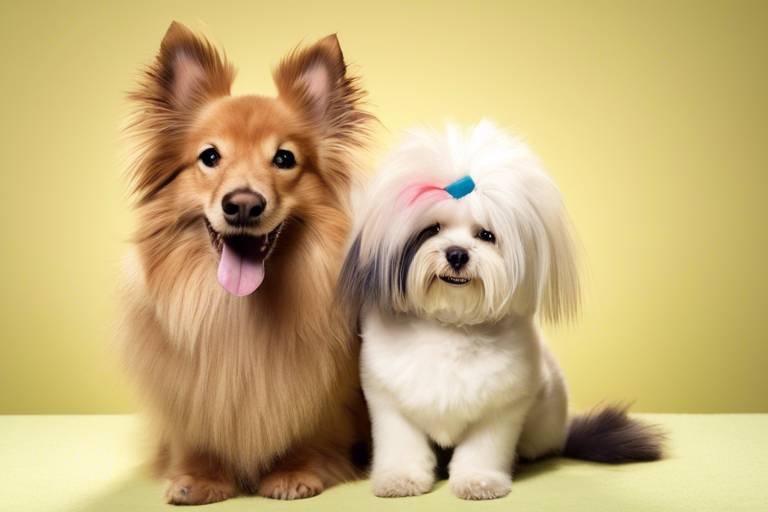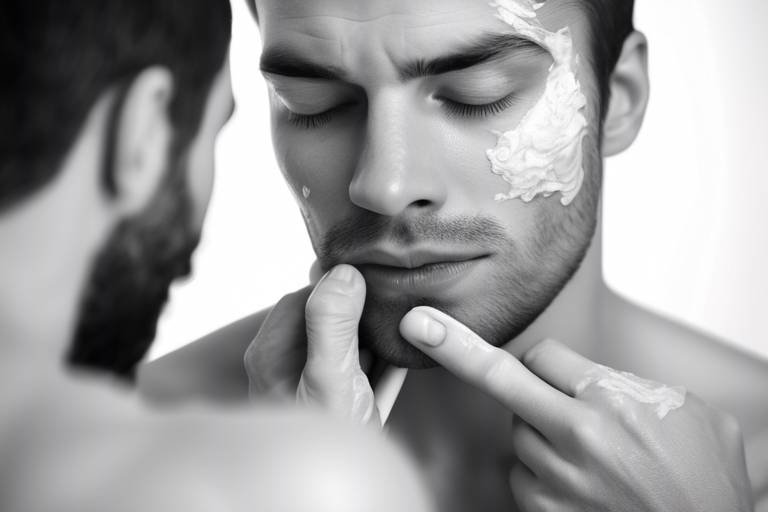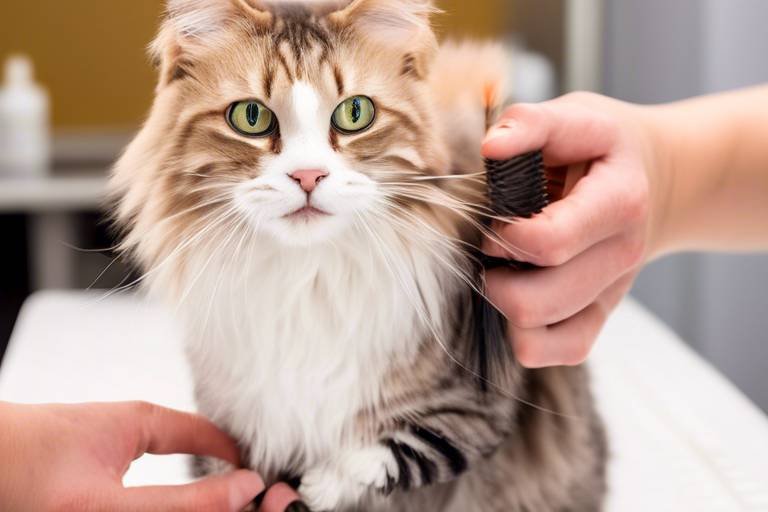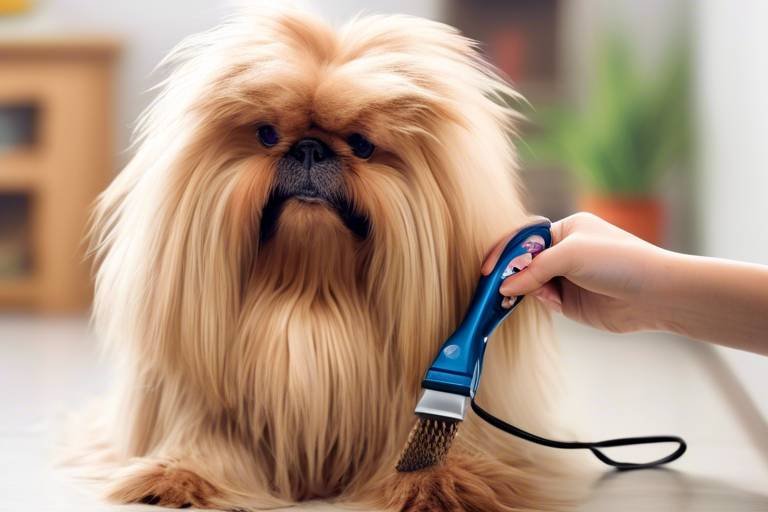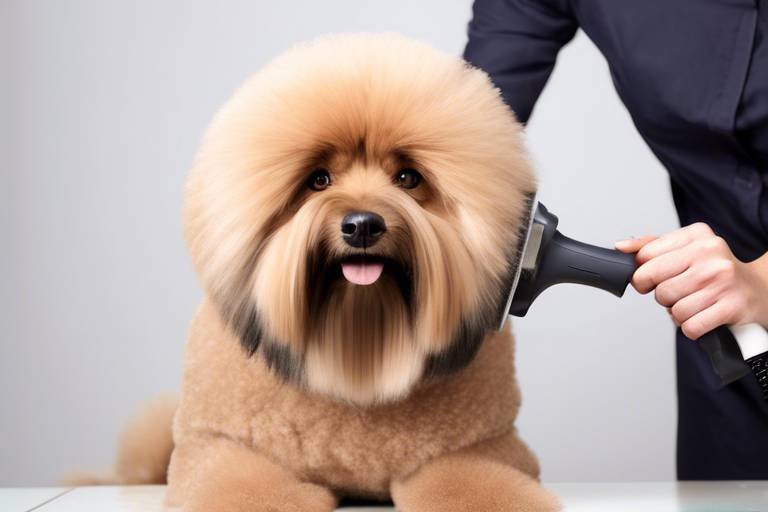The Role of Grooming in Enhancing Pet Relationships
Grooming is often perceived as a simple chore, but it actually plays a pivotal role in enhancing the bond between pets and their owners. Think of grooming as a form of communication that transcends words; it’s a way for you to express love, care, and attention to your furry friend. When you take the time to groom your pet, you’re not just making them look good; you’re also contributing to their overall health and happiness. This article explores how grooming contributes to the bond between pets and their owners, highlighting its emotional, physical, and psychological benefits for both parties involved.
Grooming goes beyond aesthetics; it plays a crucial role in a pet's health and well-being. Regular grooming sessions can significantly strengthen the relationship between pets and their owners. Imagine this: every time you brush your dog or cat, you are not only removing loose fur and dirt but also sending a message that you care about their comfort and health. This connection fosters trust, which is essential for any relationship. Moreover, grooming can be an excellent opportunity for pet owners to engage with their pets, making it a win-win situation.
Regular grooming promotes physical health in pets by preventing matting, reducing shedding, and detecting skin issues early. When you groom your pet, you're not just tidying them up; you're actively participating in their health care. For instance, a well-groomed coat can prevent painful matts that can cause skin irritation. Additionally, grooming helps in reducing shedding, which is a significant concern for many pet owners. By keeping your pet's coat in top condition, you enhance your overall bond as they feel more comfortable and are less likely to experience discomfort.
A well-groomed coat is essential for a pet's health. Regular brushing helps distribute natural oils throughout their fur, keeping it shiny and healthy. Furthermore, a clean coat is less likely to harbor parasites or irritants. Think of grooming as a spa day for your pet; it not only makes them look good but also contributes to their overall well-being. When pets feel good in their skin, they are happier and more likely to engage positively with their owners. This happiness translates into a stronger emotional bond.
Grooming can help identify and eliminate parasites like fleas and ticks. These pesky critters can cause a range of health issues for your pet, from skin irritations to more severe diseases. By regularly grooming your pet, you can spot these unwanted guests before they become a significant problem. This proactive approach not only protects your furry friend but also fosters a sense of security and trust in your relationship. When pets see their owners taking care of them, they feel loved and protected.
Grooming sessions provide an opportunity for pet owners to check for abnormalities. During grooming, you can easily spot lumps, bumps, or skin irritations that may require veterinary attention. This routine check-up is crucial for maintaining your pet's health and can lead to early detection of potential issues. The more familiar you are with your pet's body, the better equipped you are to notice changes. This connection deepens your understanding of your pet's health needs, reinforcing the bond you share.
Grooming can significantly enhance the emotional bond between pets and their owners. It’s not just about keeping your pet clean; it’s about creating an environment of trust and affection. When you groom your pet, you’re engaging in a nurturing activity that fosters a sense of security. Pets thrive on routine and predictability, and regular grooming sessions can become a cherished part of their day. This shared experience not only strengthens your relationship but also creates lasting memories.
Establishing a grooming routine can be beneficial for both pets and owners. Consistency in grooming fosters comfort and strengthens the pet-owner relationship. Just like humans, pets appreciate a predictable schedule. When grooming becomes a regular part of their lives, pets learn to anticipate and enjoy these moments. This routine can also serve as a calming mechanism for anxious pets, helping them feel more secure in their environment.
Regular grooming helps pets become accustomed to touch, which builds trust. Imagine a shy puppy who is hesitant to be touched; through gentle grooming, you can help them feel more comfortable and secure. This trust translates into a stronger emotional connection. When pets learn that grooming is a positive experience, they become more open to other forms of interaction, enhancing the overall relationship.
Grooming sessions provide an opportunity for quality bonding time. Engaging in grooming activities can enhance the pet-owner relationship through shared experiences. Whether it’s brushing, bathing, or simply cuddling during a grooming session, these moments can create lasting memories. Just think about it: every brushstroke is a chance to connect, to bond, and to show your pet how much they mean to you. This quality time is invaluable in strengthening your relationship.
- How often should I groom my pet? It depends on the breed and coat type, but generally, regular grooming every few weeks is beneficial.
- Can grooming help with my pet's anxiety? Yes, grooming can be a soothing experience that helps reduce anxiety in pets.
- What tools do I need for grooming? Basic grooming tools include brushes, combs, nail clippers, and pet-safe shampoos.
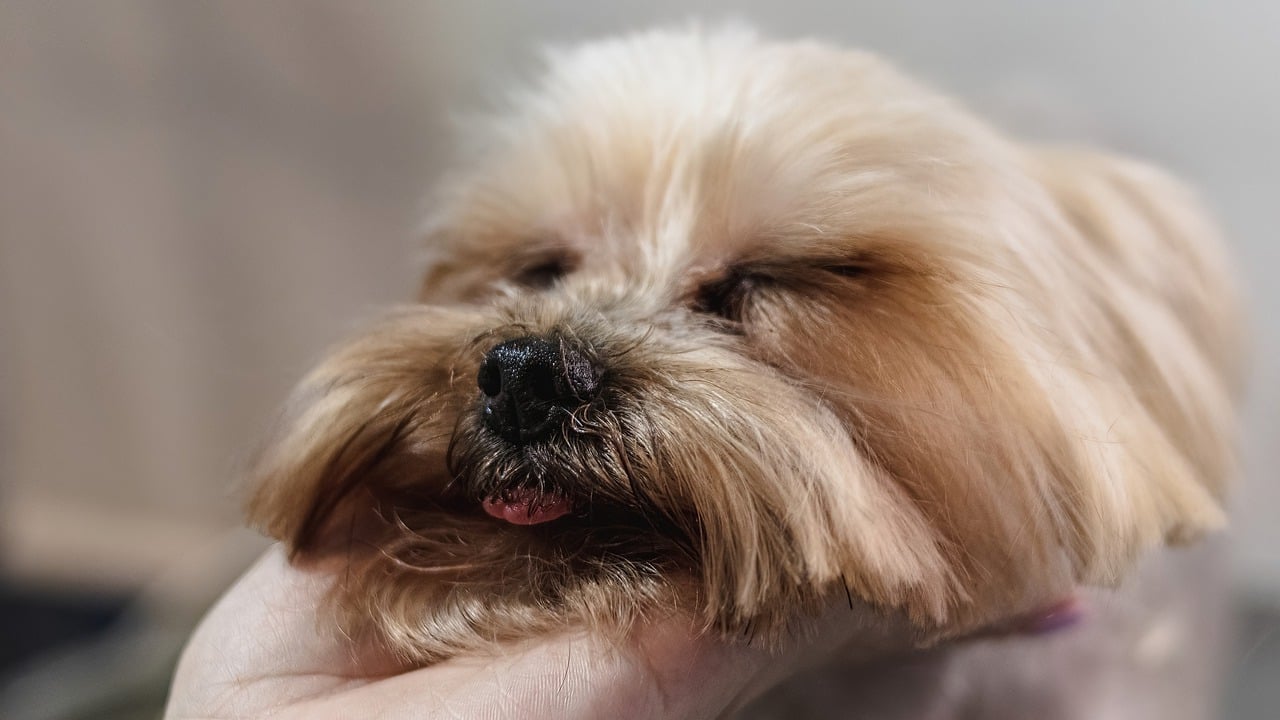
Understanding the Importance of Grooming
Grooming is often perceived as a mere cosmetic endeavor, something that makes our furry friends look fabulous for their Instagram photos. However, the reality is that grooming transcends aesthetics; it is a pivotal aspect of a pet's overall health and well-being. Just think about it: when you take the time to groom your pet, you are not only enhancing their appearance but also strengthening the bond you share. This connection is built on trust, care, and mutual understanding.
One of the most significant benefits of regular grooming is its role in promoting physical health. For instance, a well-groomed pet is less likely to suffer from matting, which can lead to skin irritations and discomfort. Regular brushing not only helps to keep their coat shiny and healthy but also reduces shedding, which means less fur on your furniture and clothes! In addition, grooming sessions provide a perfect opportunity for pet owners to check for any abnormalities on their pet's skin. This proactive approach can help catch potential health issues early on, ensuring that your furry friend stays healthy and happy.
Moreover, grooming can serve as a form of preventative care. By regularly checking your pet's coat and skin during grooming, you can easily identify signs of parasites such as fleas and ticks. These little nuisances can cause significant health problems if left unchecked. Thus, grooming becomes not just a luxury but a necessity in safeguarding your pet's health.
In essence, grooming is a multifaceted activity that goes beyond brushing and bathing. It is a chance for pet owners to engage in a holistic approach to their pets' health. By establishing a consistent grooming routine, you are sending a clear message to your pet: You are loved, and your health matters! This simple act can create an environment of comfort and security for your beloved companion.
To further illustrate the importance of grooming, consider the following table that summarizes the key benefits:
| Benefit | Description |
|---|---|
| Physical Health | Prevents matting, reduces shedding, and identifies skin issues early. |
| Emotional Connection | Strengthens the bond between pet and owner through trust and affection. |
| Preventative Care | Helps identify and eliminate parasites, reducing health risks. |
| Quality Time | Provides an opportunity for shared experiences and bonding. |
In conclusion, grooming is not merely a chore; it is an essential part of being a responsible pet owner. By prioritizing grooming, you are investing in your pet's health and happiness, which ultimately enhances the relationship you share. So next time you pick up that brush or clippers, remember that you are doing so much more than just making your pet look good—you are nurturing a bond that enriches both your lives.
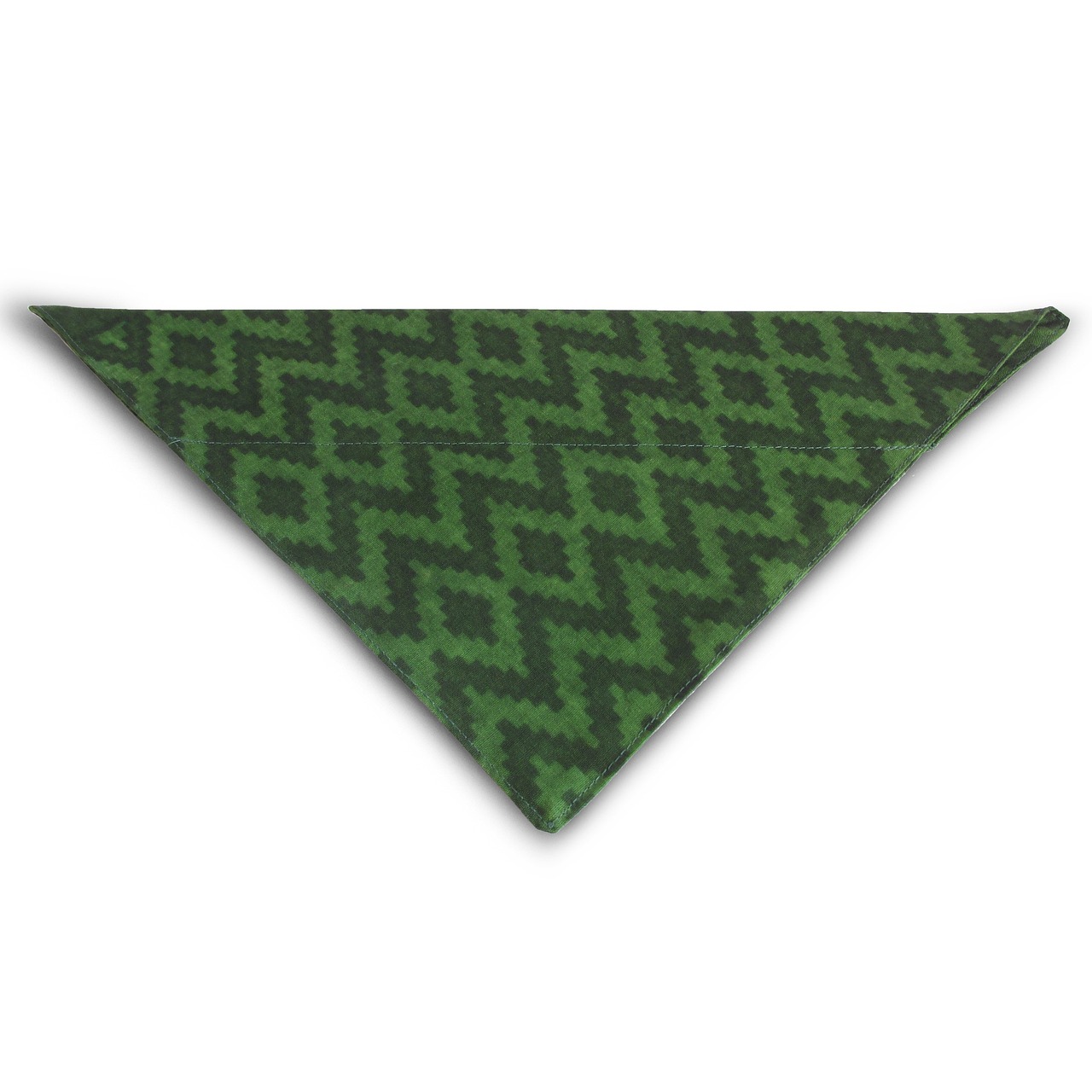
Physical Benefits of Grooming
When it comes to our furry friends, grooming is not just about making them look good; it’s a vital part of their overall health and well-being. Regular grooming sessions can significantly enhance a pet's physical condition, leading to a happier and healthier life. Think of grooming as a spa day for your pet—it’s a time to relax, bond, and ensure that they are in tip-top shape. One of the most important aspects of grooming is its ability to prevent matting, which can lead to discomfort and even skin issues. When fur becomes tangled and matted, it can pull on the skin, causing pain and irritation. By keeping your pet’s coat well-groomed, you’re not just maintaining their appearance; you’re ensuring their comfort and happiness.
Additionally, regular grooming helps reduce shedding, which is a common concern for pet owners. Excessive shedding can lead to a mess in your home and can also be a sign of underlying health issues. By grooming your pet regularly, you can manage shedding effectively, keeping your home cleaner and your pet healthier. Furthermore, grooming sessions provide an excellent opportunity for pet owners to conduct a thorough check-up on their furry companions. During these sessions, you can easily spot any abnormalities or changes in your pet’s skin or coat that may require veterinary attention. This proactive approach not only helps in maintaining your pet's health but also strengthens the bond you share.
A well-groomed coat is essential for a pet's health. Just like humans, pets need regular care to keep their skin and coat in optimal condition. Grooming helps to distribute natural oils throughout the fur, which keeps it shiny and healthy. A shiny coat is often a sign of a healthy pet! Moreover, regular grooming helps to remove dead hair, dirt, and debris, which can otherwise lead to skin irritations or infections. By keeping your pet’s coat clean and free from tangles, you’re promoting better airflow to the skin, which is crucial for its health.
Another significant benefit of grooming is its role in preventing parasites. Fleas, ticks, and other pests can wreak havoc on your pet's health if not detected early. During grooming, you can check for these unwanted guests and take appropriate action to eliminate them. This is particularly important during warmer months when parasites are more prevalent. Regular grooming can act as a first line of defense against these pests, ensuring your pet remains comfortable and healthy. Remember, a happy pet is a parasite-free pet!
Grooming sessions are not just about aesthetics; they provide a unique opportunity for pet owners to check for any abnormalities. During these sessions, you can examine your pet’s skin for lumps, bumps, or any signs of irritation. This routine check-up can lead to early detection of potential health issues, which is crucial for effective treatment. By being attentive during grooming, you foster a deeper understanding of your pet's health needs, ultimately leading to a stronger bond based on trust and care.
Skin and Coat Health
When it comes to our furry companions, their is not just a matter of appearance; it's a reflection of their overall well-being. Regular grooming plays a pivotal role in maintaining this health, ensuring that pets not only look their best but also feel comfortable and happy. Imagine your pet’s coat as a protective barrier, shielding them from environmental elements. Just like we need to take care of our skin, pets require the same attention. Grooming helps remove dirt, debris, and dead hair, which can accumulate and lead to skin irritations if left unchecked.
Furthermore, grooming is essential in preventing matting, especially in long-haired breeds. Matting can trap moisture and heat against the skin, leading to discomfort and even infections. By brushing and combing your pet's coat regularly, you not only keep it looking sleek but also promote healthy skin underneath. This process stimulates blood circulation, which is crucial for delivering nutrients to the skin and hair follicles. A well-groomed coat is often a shiny, vibrant coat, indicating a happy and healthy pet.
Additionally, grooming sessions are a fantastic opportunity for pet owners to conduct a thorough check of their pet’s skin condition. During these sessions, you can easily spot any abnormalities, such as lumps, bumps, or unusual redness, which might require a vet's attention. Early detection of skin issues can prevent more serious health complications down the line. This proactive approach not only benefits your pet's health but also strengthens the bond you share, as you become more attuned to their needs.
To sum it up, the benefits of grooming for skin and coat health are multifaceted. Here’s a quick overview:
| Benefit | Description |
|---|---|
| Prevention of Matting | Regular grooming prevents tangles and knots that can cause discomfort and skin issues. |
| Improved Blood Circulation | Brushing stimulates blood flow, promoting healthier skin and coat. |
| Early Detection of Issues | Grooming allows for the identification of skin problems before they escalate. |
| Enhanced Comfort | A clean and well-groomed coat keeps pets comfortable and happy. |
In conclusion, prioritizing grooming not only enhances your pet's appearance but significantly contributes to their skin and coat health. By investing time in grooming, you're not just maintaining their looks; you're actively participating in their health journey. So, grab that brush and start bonding with your furry friend while giving them the care they deserve!
- How often should I groom my pet? The frequency of grooming depends on the breed and coat type. Long-haired breeds may require grooming several times a week, while short-haired breeds might need it less frequently.
- Can grooming help with shedding? Yes! Regular grooming can significantly reduce shedding by removing loose hair and preventing matting.
- What tools do I need for grooming? Basic grooming tools include brushes, combs, nail clippers, and pet-safe shampoos. Specific tools may vary based on your pet's coat type.
- Is grooming stressful for pets? It can be if they aren’t used to it. Gradual exposure and positive reinforcement can help make grooming a pleasant experience.
Preventing Parasites
When it comes to keeping our furry companions safe and healthy, one of the unsung heroes is grooming. Regular grooming sessions are not just about making your pet look good; they play a vital role in such as fleas, ticks, and mites. These pesky invaders can wreak havoc on your pet's health, leading to discomfort, skin infections, and even more serious health issues if left unchecked.
During grooming, pet owners can perform a thorough inspection of their pet's coat and skin. This is crucial because many parasites can be difficult to spot until they have already caused damage. By brushing through your pet's fur, you can easily identify any unusual bumps or irritations that might indicate the presence of parasites. For instance, if you notice small black specks (often flea dirt) or tiny, moving creatures, it’s time to take action!
Moreover, grooming allows you to apply preventive treatments effectively. Many pet owners opt for topical treatments or oral medications that can help ward off these unwanted guests. By integrating these treatments into your grooming routine, you can create a comprehensive defense against parasites. Here’s a quick rundown of how grooming aids in parasite prevention:
- Regular Brushing: Helps remove loose fur and debris where parasites may hide.
- Bathing: Using specialized shampoos can kill existing parasites and soothe irritated skin.
- Spot Checks: Regularly examining your pet's skin can help catch infestations early.
Additionally, grooming sessions provide an excellent opportunity to discuss parasite prevention with your veterinarian. They can recommend the best products and practices tailored to your pet's specific needs. This proactive approach not only protects your pet but also enhances your bond as you work together to ensure their health and happiness.
In conclusion, grooming is an essential part of pet care that extends far beyond aesthetics. By making it a regular practice, you contribute significantly to your pet's overall well-being and keep those pesky parasites at bay. So, grab that brush and make grooming a fun and rewarding experience for both you and your beloved pet!
Regular Check-ups
Regular grooming sessions do more than just keep your pet looking sharp; they serve as essential check-ups that help pet owners monitor their furry friends' health. Think of grooming as a mini health assessment that happens right at home. Each time you brush your dog or cat, you're not just removing loose fur and dirt; you're also getting a close-up view of their skin, coat, and overall condition. This intimate interaction allows you to spot any abnormalities that might indicate health issues, such as lumps, bumps, or skin irritations.
During these grooming sessions, you can check for signs of common problems, including:
- Skin irritations: Redness, rashes, or unusual patches can indicate allergies or infections.
- Parasites: Fleas, ticks, and other pests can be spotted early, allowing for prompt treatment.
- Weight changes: Regular handling helps you notice if your pet is gaining or losing weight, which can be crucial for their health.
- Dental health: While grooming, you can also check your pet’s mouth for signs of dental disease, like bad breath or swollen gums.
These regular check-ups not only help in early detection of potential health issues but also foster a deeper understanding of your pet's specific health needs. It's like having a built-in vet appointment that you can conduct in the comfort of your home. Plus, the more familiar you become with your pet's body, the better equipped you'll be to notice any changes that might require a visit to the vet.
In addition to physical health, these grooming sessions create a routine that pets come to recognize. They learn to associate grooming with care and affection, which can significantly enhance their emotional well-being. This bond is strengthened as your pet starts to trust you more, knowing that you're looking out for their health and happiness. So, the next time you pick up that brush or comb, remember that you’re not just grooming; you’re engaging in a vital practice that enhances both your pet's physical health and your relationship with them.
Q: How often should I groom my pet?
A: The frequency of grooming depends on your pet's breed, coat type, and individual needs. Generally, long-haired breeds require more frequent grooming compared to short-haired ones.
Q: Can grooming help with my pet's anxiety?
A: Yes! Regular grooming can provide a sense of routine and comfort, which can help reduce anxiety in pets.
Q: What tools do I need for grooming?
A: Basic grooming tools include brushes, combs, nail clippers, and pet-safe shampoos. The specific tools you'll need may vary based on your pet's coat type.
Q: Should I take my pet to a professional groomer?
A: While regular at-home grooming is beneficial, some pets may require professional grooming, especially if they have specific grooming needs or if you’re unsure about certain techniques.
Emotional Benefits of Grooming
Grooming isn't just a matter of keeping your pet looking fabulous; it's a powerful tool that can significantly enhance the emotional bond between pets and their owners. When you engage in grooming, you're not only addressing your pet's physical needs but also nurturing their emotional well-being. Imagine this: every time you brush your furry friend, you're not just removing loose hair; you're also creating a moment of connection. This simple act can lead to a cascade of emotional benefits that can deepen your relationship.
One of the most profound impacts of grooming is the trust it fosters. Regular grooming sessions allow pets to become accustomed to human touch, which is crucial for building a safe and trusting relationship. Think of it as a dance; the more you practice, the more in sync you become. As your pet learns to trust your hands, they become more relaxed and open, which can lead to a more affectionate bond. This trust translates into a pet that is not only comfortable around you but also more responsive to your commands and cues.
Moreover, grooming provides an opportunity for quality time. In today's fast-paced world, finding moments to connect with our pets can be a challenge. Grooming sessions can serve as a dedicated time to focus on each other, away from distractions. Whether you're brushing, bathing, or simply cuddling, these moments can be incredibly enriching. They allow for shared experiences that strengthen your relationship. You might even find that your pet enjoys these sessions just as much as you do, turning grooming into a cherished ritual.
Additionally, grooming can help reduce stress and anxiety for both pets and owners. Engaging in this soothing activity can release endorphins, the body's natural feel-good hormones. For pets, the gentle strokes of a brush can be calming, much like a good massage. For owners, seeing their pets relaxed and content can be a source of joy and satisfaction. This mutual benefit creates a positive feedback loop, where both parties feel happier and more connected.
In summary, the emotional benefits of grooming are profound and multifaceted. By establishing a grooming routine, you not only enhance your pet's physical health but also create a nurturing environment that fosters trust, reduces stress, and provides valuable quality time. So the next time you pick up that brush, remember: you're not just grooming; you're strengthening the bond that makes your relationship with your pet so special.
- How often should I groom my pet? It depends on the breed and coat type, but most pets benefit from grooming at least once a month.
- Can grooming help with behavioral issues? Yes, regular grooming can reduce anxiety and improve behavior by building trust and comfort with handling.
- What tools do I need for grooming? Basic tools include a brush, comb, nail clippers, and dog-friendly shampoo.
- Is grooming stressful for pets? It can be, especially if they're not used to it. Start slowly and make it a positive experience with treats and praise.

Creating a Routine
Establishing a grooming routine is not just about keeping your pet looking fabulous; it plays a pivotal role in enhancing the bond between you and your furry friend. Think of grooming as a ritual that not only maintains your pet’s hygiene but also fosters a sense of security and trust. When you set aside regular time for grooming, you create a predictable environment that pets thrive in. Just like humans, pets appreciate routine—it gives them comfort and understanding of what to expect. Imagine the joy of your pet when they recognize the familiar sounds of brushes and clippers, or the gentle touch of your hands. They begin to associate these moments with love and care, strengthening your emotional connection.
To make grooming a seamless part of your routine, consider the following tips:
- Consistency is Key: Try to groom your pet at the same time each week. This predictability helps them know when to expect it and reduces anxiety.
- Start Slowly: If your pet is new to grooming, begin with short sessions to help them adjust. Gradually increase the time as they become more comfortable.
- Incorporate Play: Use toys or treats during grooming sessions to make it a fun experience. This will create positive associations with grooming.
Another aspect to consider is the environment in which you groom your pet. A calm, quiet space can make a world of difference. Choose a location where your pet feels safe and relaxed. You might even want to play soft music in the background to further soothe them. Remember, the goal is to make grooming a positive experience that both you and your pet look forward to.
As you develop a grooming routine, it’s essential to pay attention to your pet’s responses. Are they excited to see the grooming tools, or do they seem anxious? Adjust your approach based on their comfort level. This responsiveness not only enhances the grooming experience but also deepens your understanding of your pet’s needs, which is invaluable for building a stronger relationship.
Finally, don’t forget to celebrate the small victories! After a successful grooming session, reward your pet with praise or a treat. This reinforces the positive experience and encourages them to look forward to the next session. In essence, creating a grooming routine is about more than just cleanliness; it’s about nurturing a bond that enriches both your lives.
Q1: How often should I groom my pet?
A: The frequency of grooming depends on your pet’s breed and coat type. Long-haired breeds may require grooming several times a week, while short-haired breeds might only need it once a month.
Q2: What tools do I need for grooming?
A: Basic grooming tools include brushes, combs, nail clippers, and shampoos. The specific tools may vary based on your pet’s coat type.
Q3: Can grooming be stressful for pets?
A: It can be if not introduced properly. Start slowly, use positive reinforcement, and create a calm environment to help your pet feel at ease.
Q4: What should I do if my pet resists grooming?
A: Take a break, try shorter sessions, and use treats to encourage positive associations. Patience is key.
Building Trust Through Grooming
When it comes to our furry companions, trust is the foundation of any strong relationship. Grooming is not just a chore; it’s a golden opportunity to build that essential trust between pets and their owners. Imagine this: every time you brush your pet’s fur or trim their nails, you’re not only keeping them looking fabulous but also teaching them that they can rely on you. It’s like a gentle reminder that you are their protector, their friend, and their caregiver.
During grooming sessions, pets learn to associate touch with positive experiences. Think of it as a bonding ritual. As you run your fingers through their coat or gently clean their ears, you are communicating affection and care. This tactile interaction helps pets feel safe and secure, reinforcing the idea that their owner is someone they can trust. It’s a bit like a parent soothing a child; the more you nurture, the stronger the bond becomes.
Moreover, consistent grooming routines can help pets become accustomed to being handled in various ways. For instance, if you regularly check their paws, they will gradually learn that it’s okay to have their feet touched. This can be critical for visits to the vet or during emergencies when they might need to be handled more than usual. By fostering this comfort through grooming, you’re essentially preparing them for life’s little surprises.
Additionally, grooming allows for a unique form of communication. Pets may not speak our language, but they express their feelings in their own ways. During grooming, you can observe their reactions—whether they’re relaxed, anxious, or playful. This feedback is invaluable. It helps you understand their comfort levels and preferences, further deepening the trust between you. It’s like having a conversation where both parties are learning and adapting to each other’s needs.
In essence, grooming is much more than a practical necessity; it’s an essential part of the emotional landscape shared between pets and their owners. By dedicating time to groom your pet, you’re investing in a relationship built on trust, understanding, and love. So, the next time you pick up that brush or nail clipper, remember that you’re not just grooming—you’re nurturing a bond that will last a lifetime.
Grooming as Quality Time
Grooming is not just a chore; it's an opportunity for quality bonding between you and your pet. Imagine this: you and your furry friend, cozy in your living room, surrounded by the soothing sounds of gentle brushing and the occasional playful nuzzle. It's during these grooming sessions that you can truly connect with your pet on a deeper level. The act of grooming allows you to engage in a shared experience that can enhance your relationship, making it more fulfilling for both of you.
When you set aside time to groom your pet, you're not only taking care of their physical needs but also investing in your emotional connection. Think of grooming as a form of pet therapy—it’s a time to relax, unwind, and enjoy each other’s company. As you brush their fur, you might notice how their eyes close in bliss, or how they lean into your touch, signaling their trust and affection. This mutual enjoyment creates a bond that goes beyond the surface.
Moreover, grooming can be a fun activity! You can incorporate playfulness into the routine by using treats or toys to keep your pet engaged. For example, you can reward your dog with a treat after a good brushing session or play a game of tug-of-war with their favorite toy during breaks. This not only makes grooming enjoyable but also reinforces positive behavior, making your pet look forward to these moments.
Consider creating a grooming schedule that suits both your and your pet's needs. Whether it's a weekly brushing or a monthly bath, having a routine can help your pet feel more comfortable and secure. Here’s a simple table to illustrate a potential grooming schedule:
| Grooming Activity | Frequency | Duration |
|---|---|---|
| Brushing | Weekly | 15-30 minutes |
| Bathing | Monthly | 30 minutes |
| Nail Clipping | Every 2 weeks | 10 minutes |
As you establish this routine, you’ll find that grooming becomes a cherished part of your relationship. The more comfortable your pet becomes with the grooming process, the more they will look forward to it, reinforcing a sense of trust and safety. So, the next time you pick up that brush or clippers, remember that it's not just about keeping your pet looking their best—it's about creating lasting memories and strengthening the bond you share.
- How often should I groom my pet? The frequency of grooming depends on your pet's breed and coat type. Generally, long-haired breeds require more frequent grooming than short-haired ones.
- Can grooming help with behavioral issues? Yes, regular grooming can help reduce anxiety in pets and improve their overall behavior by building trust and familiarity.
- What tools do I need for grooming? Basic grooming tools include brushes, combs, nail clippers, and pet shampoo. It's essential to choose the right tools for your pet's specific needs.
- Is grooming painful for pets? When done correctly, grooming should not be painful. Always be gentle and take breaks if your pet seems uncomfortable.
Frequently Asked Questions
- Why is grooming important for my pet?
Grooming is essential for your pet's health and well-being. It helps prevent matting, reduces shedding, and allows you to spot skin issues early. Plus, it creates a wonderful opportunity for bonding, enhancing the relationship between you and your furry friend.
- How often should I groom my pet?
The frequency of grooming depends on your pet's breed, coat type, and individual needs. Generally, long-haired breeds may require grooming several times a week, while short-haired breeds might only need it once a month. Establishing a routine helps your pet become comfortable with the process.
- Can grooming help with my pet's emotional well-being?
Absolutely! Grooming sessions can build trust and affection between you and your pet. The physical touch and attention during grooming can make your pet feel secure and loved, which strengthens your emotional bond.
- What are the physical benefits of grooming?
Regular grooming promotes skin and coat health, prevents parasites, and allows for early detection of any health issues. A well-groomed pet is not only healthier but also happier, which reflects positively on your relationship.
- How can I make grooming a positive experience for my pet?
Start slowly and use positive reinforcement, like treats and praise, to create a positive association with grooming. Make it a fun and relaxed time, and soon your pet will look forward to those grooming sessions as quality bonding time!
- What tools do I need for grooming?
The tools you'll need depend on your pet's coat type. Common grooming tools include brushes, combs, nail clippers, and shampoos. Investing in the right tools can make the grooming process easier and more enjoyable for both you and your pet.
- Can I groom my pet at home?
Yes, many pet owners choose to groom their pets at home! With the right tools and techniques, you can maintain your pet's coat and health. However, for more complex grooming needs, consider seeking professional help.
- How does grooming help in detecting health issues?
During grooming, you have the chance to closely examine your pet's skin, coat, and body for any unusual signs, such as lumps, bumps, or irritations. This proactive approach can help you catch potential health problems early, ensuring your pet stays healthy.








